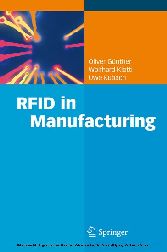Suchen und Finden
Service
RFID in Manufacturing
Oliver P. Günther, Wolfhard Kletti, Uwe Kubach
Verlag Springer-Verlag, 2008
ISBN 9783540764540 , 175 Seiten
Format PDF, OL
Kopierschutz Wasserzeichen
Geräte
Preface
5
Contents
8
Chapter 1 RFID in Manufacturing: From Shop Floor to Top Floor
16
1.1 Architectural Perspectives
16
1.2 RFID Basics and Standards
21
1.2.1 Technical Foundations
22
1.2.2 EPCglobal ™
25
1.2.3 OPC and OPC-UA
28
1.2.4 ISA-95
29
1.3 RFID Potentials
31
1.3.1 Scanning
31
1.3.2 Tracking
32
1.3.3 Tracing
33
1.3.4 Metadata Management
33
1.3.5 Back-End Communication
34
1.3.6 Label Management
35
1.3.7 Inter-Enterprise Collaboration
35
1.4 Cost–Benefit Considerations and Adoption Decision
36
1.5 Summary
38
Chapter 2 The Role of Enterprise Software
40
2.1 Trends in Manufacturing and ERP
40
2.2 Enterprise Service-Oriented Architectures
41
2.3 SAP Software for Real-World Awareness
42
2.4 SAP Auto-ID Infrastructure
44
2.4.1 System Requirements
44
2.4.2 System Overview
45
2.5 Summary
49
Chapter 3 The Role of Manufacturing Execution Systems
50
3.1 Why an MES ?
50
3.2 Integrating MES into the Enterprise Information Infrastructure
52
3.3 Processes Relevant to MES in the Company
54
3.3.1 Time Scheduling and Sequencing, Shop Floor Control ( also refer to Sect. 3.7.6 )
56
3.3.2 Intralogistics ( see also Sect. 3.7.3 )
56
3.3.3 Quality Management ( see also Sect. 3.7.4 )
57
3.3.4 Time and Attendance and Time Management Within Production ( see also Sect. 3.7.5 )
57
3.4 Tasks and Functions of an MES
58
3.5 Data Collection During Manufacturing
62
3.5.1 Data Collection Station
63
3.5.2 Connection of the Automation Layer
64
3.6 Flow of Information
66
3.7 RFID and MES
67
3.7.1 Identifying Objects in Production
67
3.7.2 Realization of Online Interfaces
69
3.7.3 Intra-Enterprise Logistics
70
3.7.4 Quality Management
71
3.7.5 Access and Attendance Control
72
3.7.6 Shop Floor Control
73
3.8 Summary
74
Chapter 4 Six Case Studies
75
4.1 AIR: Airbag Manufacturing
75
4.1.1 Current Situation
76
4.1.2 RFID Perspectives
80
4.1.3 Costs and Benefits
85
4.1.4 Summary
86
4.2 CLU: Sliding Clutches
86
4.2.1 Current Situation
87
4.2.2 RFID Perspectives
90
4.2.3 Costs and Benefits
94
4.2.4 Summary
95
4.3 COO: Engine-Cooling Modules
95
4.3.1 Current Situation
96
4.3.2 RFID Perspectives
98
4.3.3 Costs and Benefits
99
4.3.4 Summary
99
4.4 CAS: Production of Cast Parts
99
4.4.1 Current Situation
100
4.4.2 RFID Perspectives
102
4.4.3 Costs and Benefits
104
4.4.4 Summary
105
4.5 CON: Production of Electronic Connectors
105
4.5.1 Current Situation
106
4.5.2 RFID Perspectives
110
4.5.3 Costs and Benefits
114
4.5.4 Summary
115
4.6 PAC: Aluminum Foils for Packaging
115
4.6.1 Current Situation
116
4.6.2 RFID Perspectives
122
4.6.3 Costs and Benefits
125
4.6.4 Summary
125
4.7 Summary
125
Chapter 5 Lessons Learned
127
5.1 Terminology
127
5.2 A Reference Model for Production
129
5.3 Motives for Using RFID
131
5.3.1 Accelerating Scan Processes
131
5.3.2 Extending Scan Processes for Quality and Efficiency
132
5.3.3 Extending Scan Processes for Narrowing Recalls
133
5.3.4 Reducing Paper-Based Data Management
133
5.3.5 Automating Asset Tracking
134
5.3.6 Reducing Back-End Interactions
135
5.3.7 Unifying Labels
136
5.4 RFID Versus Barcode
137
5.4.1 Monitoring Processes
138
5.4.2 Management of Process Data
138
5.4.3 Container Management
139
5.4.4 Uniform Labeling
139
5.4.5 Process Safety
139
5.5 A Guide to Assess Costs and Benefits1
140
5.5.1 Costs
141
5.5.2 Benefits
145
5.6 Basic RFID Functionalities
152
5.6.1 Filtering and Enriching RFID Data
152
5.6.2 Storing RFID Data
153
5.6.3 Sharing Information Along the Supply Chain
153
5.6.4 Event Detection
154
5.7 Requirements for the IT Infrastructure
155
5.7.1 Providing RFID Data to Components of ISA-95 Level 3
156
5.7.2 Distributing Business Logic and Data
157
5.7.3 Supporting Heterogeneous Data Sources
159
5.7.4 Dealing with Noise and Uncertainty
160
5.7.5 Supporting Process Analysis
160
5.7.6 Supporting Asset Tracking
160
5.8 Hardware Issues on the Plant Floor
161
5.8.1 Hostile Physical Conditions
161
5.8.2 Presence of Metal
162
5.8.3 Demand for Wireless Communication
162
5.8.4 Processes in Close Spatial Proximity
163
5.9 Current Motives and Open Potential for Using RFID
163
5.10 Summary
165
Chapter 6 Conclusions and Outlook
167
References
170
Subject Index
173
Service
Shop



